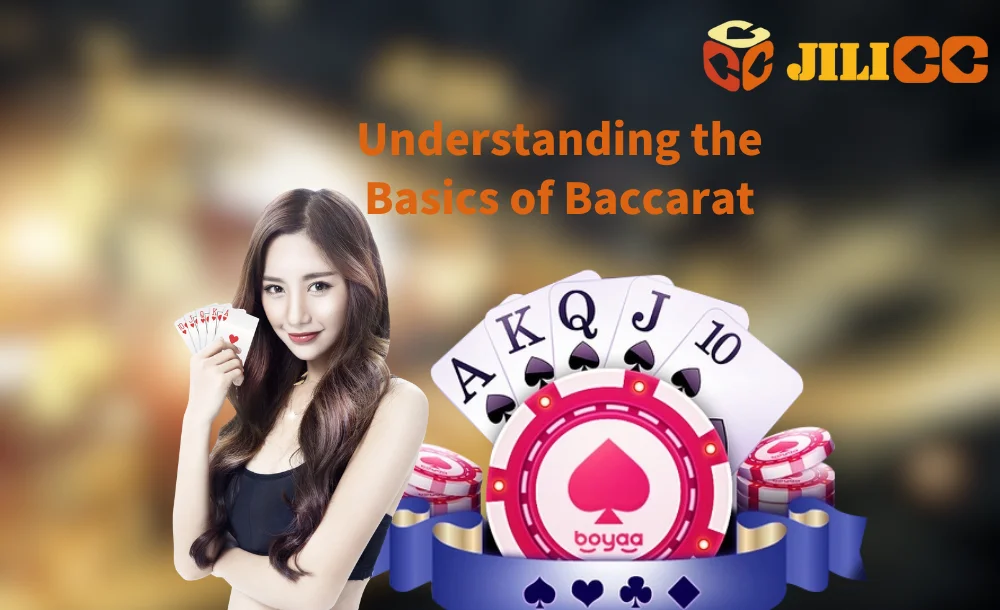Baccarat, a card game often associated with high rollers and elite casino environments, has a captivating charm that is hard to resist. With its elegant simplicity and blend of chance and strategy, it has captivated players for centuries, from the opulent halls of Monte Carlo to online platforms like JILICC. Whether you are a seasoned gambler or a curious novice, understanding the gameplay and rules of Baccarat can significantly enhance your enjoyment and potentially increase your chances of winning.

Understanding the Basics of Baccarat
Before delving into more complex strategies and betting techniques, it’s essential to understand the fundamental principles that frame Baccarat. Knowing these basics not only enhances your gameplay experience but also provides clarity when navigating through various betting options and strategies.
The Objective of Baccarat
the main goal of Baccarat is straightforward: players must predict which hand – the Player’s or the Banker’s – will have a point total closest to 9. Unlike many casino games where players often bet on themselves to win, Baccarat operates under a different paradigm. Here, you’re actually wagering on either the Player or the Banker hand, striving to foresee which one will ultimately prevail.
Card Values and Scoring in Baccarat
Understanding how card values are calculated in Baccarat is paramount. Each card holds a specific value which contributes to the overall score of a hand:
- Number Cards (2-9): They possess their face value; for instance, a 7 is worth 7 points.
- Tens and Face Cards (10, Jack, Queen, King): These cards hold no value, contributing 0 points.
- Ace: It is valued at 1 point.
When calculating the point total of a hand, the last digit of the sum is what matters. For example, if a hand consists of a 7 and a 5, the total is 12, but since only the last digit is considered, the hand total would be 2. Similarly, a hand with a 9 and a King totals 9, as the King contributes nothing to the value of the hand.
This unique scoring system adds an interesting layer to the game. It encourages players to think critically about potential combinations, even though pure chance plays a significant role in determining outcomes.
Baccarat Terminology for Beginners
Familiarizing yourself with common Baccarat terminology is vital for enhancing your understanding and participation in the game. Here are some key terms that every beginner should know:
- Player: This term refers to one of the two competing hands in the game.
- Banker: This term represents the other hand, often favored due to its slightly better odds.
- Tie: A tie occurs when both the Player and Banker hands achieve the same point total, leading to a stalemate scenario.
- Natural: In Baccarat, a natural is defined as a hand totaling 8 or 9 on the initial deal.
- Third Card: This is an additional card dealt in particular situations based on predetermined rules.
- Coup: A single round of Baccarat is referred to as a coup.
Becoming conversant in these terms allows beginners to engage with the game more fluently, fostering confidence when placing bets or discussing strategies with fellow players. Understanding the lingo can also transform what might initially feel like a daunting experience into an enjoyable journey into the world of Baccarat.

See More: How to Master JILICC BlackJack Live Casino in Easy Steps
How to Play JILICC Baccarat: Step-by-Step Guide
Armed with a solid foundation regarding Baccarat fundamentals, it’s time to explore how to play on the JILICC platform specifically. This step-by-step guide will simplify the process, making it accessible for beginners who wish to dive into the game.
Placing Your Bets
Before the cards are dealt, players must first place their wagers. In Baccarat, you can choose to bet on either the Player, the Banker, or a Tie. Each of these options comes with distinct odds and payouts.
- Player Bet: If the Player hand achieves a higher point total than the Banker, the player wins. This option tends to attract those willing to take a moderate risk with decent reward potential.
- Banker Bet: The Banker bet is usually the most popular, owing to its lower house edge. When wagering on the Banker, you win if the Banker’s hand beats the Player’s. This option typically offers more favorable odds.
- Tie Bet: Betting on a tie can yield significantly higher payouts, appealing to those adventurous players willing to take the highest risk for the possibility of a substantial reward.
JILICC provides a user-friendly interface for placing bets. Users can conveniently select their preferred wager, input the amount they wish to risk, and confirm their bet with just a few clicks. This ease of use simplifies the betting process, allowing players to focus on enjoying the game rather than getting bogged down by technicalities.
The Dealing Process
Once all bets are placed, the dealer initiates the action by dealing two cards to both the Player and Banker hands. These initial cards play a crucial role in determining whether either hand achieves a Natural (a total of 8 or 9).
If either hand receives a Natural, the round concludes promptly, and the winning hand is declared. This quick resolution adds an exciting dynamic to the game, keeping players on their toes and engaged with each round.
However, if neither hand ends up being a Natural, the game continues, and specific rules dictate whether a third card is drawn. This aspect introduces another layer of strategy and decision-making into the game, making it imperative for players to understand how these rules operate.
Determining the Winner
After the dealing process, determining the winner hinges on a set of established rules governing the drawing of a third card for both the Player and Banker hands.
For the Player’s hand, if the total is 5 or less, a third card is drawn. On the other hand, if the Player has a total of 6 or 7, they do not draw a third card. The rules for the Banker’s hand are slightly more complicated and take into consideration the Player’s third card (if drawn) alongside the Banker’s existing two-card total.
Here’s a brief outline of the rules guiding the Banker’s decision to draw a third card:
- If the Banker has a total of 2 or less, they draw a third card.
- If the Banker has a total of 3, they will draw a third card unless the Player’s third card is an 8.
- If the Banker holds a total of 4, a third card is drawn unless the Player’s third card falls between 2 and 7.
- If the Banker has a total of 5, they draw unless the Player’s third card is a 4, 5, 6, or 7.
- Lastly, if the Banker has a total of 6, a card is drawn unless the Player’s third card is a 6 or 7.
- Finally, a Banker with a total of 7 does not draw a third card.
Once all the rules have been applied and any necessary third cards have been drawn, the final hand totals are compared. The hand with the score closest to 9 emerges as the victor, bringing closure to the tension-filled round.

Key Strategies for Winning at Baccarat
Though Baccarat is predominantly a game of chance, there are strategies available that aspiring players can employ to improve their odds. While no strategy guarantees victory, being informed and employing sound tactics can help enhance your gaming experience.
Betting Systems in Baccarat
Various betting systems have emerged from the minds of players hoping to maximize their profits while minimizing their risks. Here are three popular strategies:
- Martingale System: This approach revolves around doubling your bet after every loss, under the assumption that eventually, you will recover not only your losses but also make a profit when you finally win. However, the Martingale system carries the inherent risk of losing a significant sum during extended losing streaks, making it crucial to approach this method cautiously.
- Paroli System: In contrast to Martingale, the Paroli system entails doubling your bet after each win. This strategy aims to capitalize on winning streaks while maintaining a more conservative outlook regarding losses. By protecting against substantial losses, players can focus on maximizing their gains instead.
- Fibonacci System: Based on the Fibonacci sequence, this strategy involves increasing your bet according to the sequence – for example, 1, 1, 2, 3, 5, 8. This method seeks to balance risk management with profit potential, providing players with a structured betting plan.
While these systems offer structured approaches to betting, it’s critical to remember that they cannot guarantee consistent wins in Baccarat. Instead, players should utilize them to manage their bankroll effectively and optimize their bets while remaining mindful of the inherent risks involved.
Understanding House Edge and Odds
Another pivotal concept in understanding Baccarat is the house edge—an advantage that the casino maintains over the players in any gambling game. In Baccarat, the house edge varies depending on the type of bet made:
- Banker Bet: Typically, the Banker bet features a lower house edge (around 1.06%) compared to the Player bet, making it a commonly recommended choice among experienced players.
- Player Bet: The Player bet carries a slightly higher house edge (approximately 1.24%), providing players with reasonable opportunities but not as favorable as the Banker.
- Tie Bet: The Tie bet presents the highest house edge (around 14.4%), making it the least favorable option for conscientious players.
Understanding the odds associated with each type of bet empowers players to make informed decisions. Given the lower house edge, the Banker bet is generally regarded as the optimal choice for maximizing winning chances, particularly for beginners still trying to grasp the nuances of the game.

Visit JILICC Live Casino to learn more about live casino gaming!
Conclusion
Baccarat is a game that artfully blends simplicity and excitement, appealing to a diverse range of players within the casino landscape. By comprehending the core principles, card values, and the intricacies of the Third Card Rule, you can engage more effectively in the game.
Utilizing online platforms like JILICC provides a convenient and enjoyable setting to learn and play Baccarat, while experimenting with various strategies can further enhance your skills. Remember, however, that gambling should primarily be a form of entertainment. By incorporating the insights shared in this guide, you’ll be better equipped to navigate the thrilling world of Baccarat, embracing both the challenge and enjoyment that this classic casino game brings.
